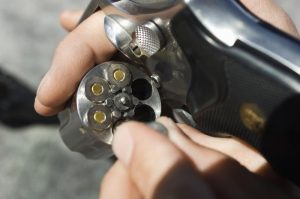Gunshot Wound Cases: Determining the Distance
 There are over 115,000 gunshot wound incidents resulting in nonfatal injury the US annually; though just a fraction go to trial.
There are over 115,000 gunshot wound incidents resulting in nonfatal injury the US annually; though just a fraction go to trial.
Gunshot wounds can be self-inflicted, accidental or intentional, or inflicted from another person, accidental or intentional. Determining the nature of the injury and the location of the weapon in relation to the targeted area of the body may be a key element in determining culpability.
Legal nurse consultants assist attorneys in evaluating the evidence in gunshot wound cases. What do we need to do that? Photographs and written descriptions of the wound (from medical records) are key.
Provided the necessary information and evidence is available, such as detailed photographic (preferably) and written descriptions of the entrance wounds, a legal/forensic nurse consultant may be able to determine an estimated distance of fire range or the distance between the victim and gun at the time of discharge.
Although we cannot determine the precise distance of the muzzle from the entrance wound, there are specific characteristics of gunshot wounds at the entry point that allow us to make an approximation of the distance. These ranges and characteristics include:
- Contact/Firm Contact: The firearm is firmly held in contact with the skin at the time of discharge, most of the gases, gunpowder and flames enter the wound. What you’ll see: presence of a muzzle-imprint to the skin around the entrance wound due to gas expansion within the subcutaneous tissue OR an irregular-shaped wound with central defect and radiating lacerations (most commonly found in gunshot wounds to the head)
- Contact/Loose Contact: The firearm is in loose contact with the skin/target. You’ll see a circular entrance wound with blackened, seared margins, singed hairs.
- Near Contact/Close-range: The firearm is held a very short distance from the skin/target, generally less than 6 inches. What you’ll see: flame burns at the edges of the entrance wound, singed hair, soot deposits, stippling (red/orange or brown punctate abrasions resulting from pieces of gunpowder expelled from the barrel and striking the skin).
- Mid-range/Intermediate-range: In this range, the firearm is 6-30 inches between the weapon and the skin/target. What you’ll see: Stippling around the entrance wound; the greater the distance the larger the stippling surface area with lower concentrations
- Far-range/Distant: When the firearm is beyond 30 inches from the skin – what you’ll see is a grease collar around the entrance wound from lubricant and embedded particles that accompanied the bullet as it propelled from the weapon to the skin/targe, absence of stippling, soot, or singed hair.
LNCs are vital members of civil litigation teams; the same can be said for criminal cases as well. In fatal and non-fatal gunshot wound cases, LNCs evaluate the medical evidence and gunshot wound characteristics to estimate the distance of fire. This assistance may be key in supporting or refuting statements of the victim, suspect and witnesses and distinguishing between an accidental, self-inflicted or intentional shooting.
 Teresa Devitt Lynch is a certified adult Sexual Assault Nurse Examiner and board certified Advanced Forensic Nurse. The proprietor of the INTREPID Forensic Healthcare Consulting firm, she provides criminal case consultation and expert witness services for military and civilian courts. Recently relocated to North Dakota, Teresa provides services to victims of sexual assault and battering.
Teresa Devitt Lynch is a certified adult Sexual Assault Nurse Examiner and board certified Advanced Forensic Nurse. The proprietor of the INTREPID Forensic Healthcare Consulting firm, she provides criminal case consultation and expert witness services for military and civilian courts. Recently relocated to North Dakota, Teresa provides services to victims of sexual assault and battering.
Get firsthand experience evaluating gunshot wound cases at our 2-day virtual conference, The Path of the Bullet: A Guide to Criminal Cases. Meet Teresa Devitt Lynch, the author of this blog, Pat Iyer and our panel of expert forensic nurses, attorneys and a ballistics expert. Get your seat here.
References:1. UC Davis Health (n.d). Firearm injury prevention: Resources for health care providers. Retrieved from: https://health.ucdavis.edu/what-you-can-do/
2. Gitto L, Stoppacher R. Gunshot wounds. PathologyOutlines.com website. https://www.pathologyoutlines.com/topic/forensicsgunshotwounds.html
3. Shrestha R, Kanchan T, Krishan K. Gunshot Wounds Forensic Pathology. [Updated 2021 Jul 20]. In: StatPearls [Internet]. Treasure Island (FL): StatPearls Publishing; 2021 Jan-. Available from: https://www.ncbi.nlm.nih.gov/books/NBK556119/
